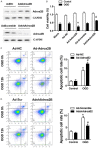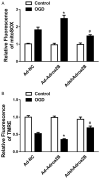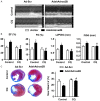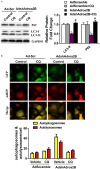Decreased expression of adenosine receptor 2B confers cardiac protection against ischemia via restoring autophagic flux
- PMID: 33437375
- PMCID: PMC7791490
Decreased expression of adenosine receptor 2B confers cardiac protection against ischemia via restoring autophagic flux
Abstract
Adora2B (adenosine receptor 2B) has been reported as one of the key modulators during cardiac remodeling after acute myocardial infarction (AMI). However, the molecular mechanism involved has not been well investigated. Thus, our study aims to investigate whether Adora2B contributes to cardiac remodeling after AMI and its underlying mechanisms. Adenovirus harboring Adora2B or shAdora2B was injected in the border zone in a mouse model of AMI experimentally produced by permanent ligation of left anterior descending (LAD) coronary artery. Decreased Adora2B expression protected the cardiomyocytes from MI-induced autophagic flux obstacle, improved cardiac function, and reduced fibrosis after MI. Adora2B downregulation attenuated the accumulation of LC3-II and p62, which are autophagy substrate proteins. An adenovirus containing mRFP-GFP-LC3 showed that decreased expression of Adora2B restored the autophagic flux by enhancing autophagosome conversion to autophagolysosome. Also, Adora2B knockdown improved cardiomyocytes' survival and protected mitochondrial function of cardiomyocytes insulted with hypoxia. Notably, the effect of Adora2B on autophagy flux and cardiomyocyte protection could be mitigated by autophagy inhibitor chloroquine. Our results demonstrate that decreased expression of Adora2B protected cardiomyocytes from impaired autophagy flux induced by MI. Modulation Adora2B expression plays a significant role in blunting the worsening of heart function and reducing scar formation, suggesting therapeutic potential by targeting Adora2B in AMI for the infarct healing.
Keywords: Acute myocardial infarction; Adora2B; apoptosis; autophagy flux.
AJTR Copyright © 2020.
Conflict of interest statement
None.
Figures






Similar articles
-
Increased expression of DRAM1 confers myocardial protection against ischemia via restoring autophagy flux.J Mol Cell Cardiol. 2018 Nov;124:70-82. doi: 10.1016/j.yjmcc.2018.08.018. Epub 2018 Aug 23. J Mol Cell Cardiol. 2018. PMID: 30144448
-
Nobiletin attenuates adverse cardiac remodeling after acute myocardial infarction in rats via restoring autophagy flux.Biochem Biophys Res Commun. 2017 Oct 14;492(2):262-268. doi: 10.1016/j.bbrc.2017.08.064. Epub 2017 Aug 19. Biochem Biophys Res Commun. 2017. PMID: 28830813
-
Inhibition of Histone Deacetylases Prevents Cardiac Remodeling After Myocardial Infarction by Restoring Autophagosome Processing in Cardiac Fibroblasts.Cell Physiol Biochem. 2018;49(5):1999-2011. doi: 10.1159/000493672. Epub 2018 Sep 20. Cell Physiol Biochem. 2018. PMID: 30235443
-
Cardioprotective effect of MLN4924 on ameliorating autophagic flux impairment in myocardial ischemia-reperfusion injury by Sirt1.Redox Biol. 2021 Oct;46:102114. doi: 10.1016/j.redox.2021.102114. Epub 2021 Aug 24. Redox Biol. 2021. PMID: 34454165 Free PMC article.
-
Alternative adenosine Receptor activation: The netrin-Adora2b link.Front Pharmacol. 2022 Jul 15;13:944994. doi: 10.3389/fphar.2022.944994. eCollection 2022. Front Pharmacol. 2022. PMID: 35910389 Free PMC article. Review.
Cited by
-
M2b macrophages protect against doxorubicin induced cardiotoxicity via alternating autophagy in cardiomyocytes.PLoS One. 2023 Jul 27;18(7):e0288422. doi: 10.1371/journal.pone.0288422. eCollection 2023. PLoS One. 2023. PMID: 37498828 Free PMC article.
-
FUNDC1: a key mediator of adenosine A2BR activation-induced inhibition of cardiac mitophagy under ischemia/reperfusion conditions.Cardiovasc Diagn Ther. 2023 Jun 30;13(3):509-522. doi: 10.21037/cdt-22-468. Epub 2023 May 8. Cardiovasc Diagn Ther. 2023. PMID: 37405013 Free PMC article.
References
-
- Ruparelia N, Godec J, Lee R, Chai JT, Dall’Armellina E, McAndrew D, Digby JE, Forfar JC, Prendergast BD, Kharbanda RK, Banning AP, Neubauer S, Lygate CA, Channon KM, Haining NW, Choudhury RP. Acute myocardial infarction activates distinct inflammation and proliferation pathways in circulating monocytes, prior to recruitment, and identified through conserved transcriptional responses in mice and humans. Eur Heart J. 2015;36:1923–34. - PMC - PubMed
-
- Nakai A, Yamaguchi O, Takeda T, Higuchi Y, Hikoso S, Taniike M, Omiya S, Mizote I, Matsumura Y, Asahi M, Nishida K, Hori M, Mizushima N, Otsu K. The role of autophagy in cardiomyocytes in the basal state and in response to hemodynamic stress. Nat Med. 2007;13:619. - PubMed
-
- Nishida K, Taneike M, Otsu K. The role of autophagic degradation in the heart. J Mol Cell Cardiol. 2015;78:73–79. - PubMed
LinkOut - more resources
Full Text Sources
